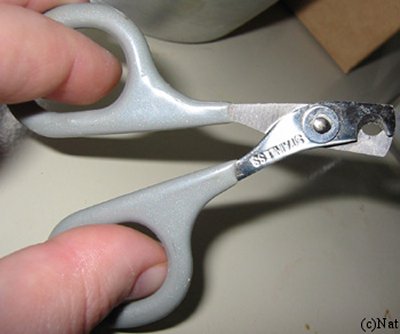Figure 3: Trimming teeth
Photos and descriptions
 Photo 1: With her mouth closed, the bottom teeth can be seen just touching the top of her mouth. If you notice, her bottom teeth are not flat but rather have a diagonal slant going from outside top to inside middle. |
 Photo 2: Shows her bottom teeth are splayed. Based on this and the fact that her teeth have a flat diagonal slant, you can assume that she is drilling her teeth down; however, because they are not together, she is only able to do so much. |
 Photo 3: Shows the separation in the teeth. Trimming both of these at once will more than likely lead to an imprecise cut of both, shattering or splintering of the teeth. As such, we are going to trim them one at a time. It’s easier to use the cat claw snips here, to do teeth one at a time, but she doesn’t like those snips so we’re doing it the hard way. I’ve looked for where the tooth becomes opaque (see arrows, above in Photo 2.) to determine where to cut, but since she’s also trimming them down herself, I’m going to be a little conservative. I’m cutting right at the end of the line where she’s obviously drilled them down to herself. |
 Photo 4: Shows the cat’s claw snips for use on one tooth. If she had allowed these snips it would of been much easier. |
 Photo 5: Shows the tooth on the left has been cut and I’m now going to trim the right one. Notice that I’m making sure her tongue’s not between the snips and her tooth. |
 Photo 6: On the left you can see the tooth I’ve already trimmed. On the right I’ve rotated the clips so the curvature of the snips match the curvature of the tooth itself. It would be good to even up those top teeth to help her get a better, straighter, grind on those bottom teeth but because the top teeth are already so short, I can’t do that. |
*Note: For the purposes of these photos, one person is shown doing the trimming; however, for better support of the rat and for precision trimming it really does take TWO people!*
Photos courtesy of Nathalie Baldwin at RatRaisins,Inc


